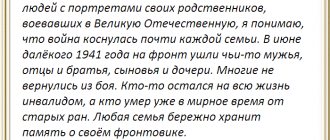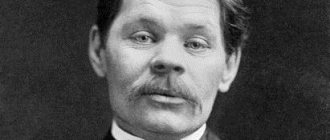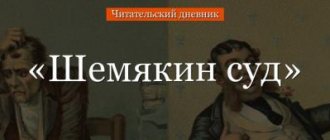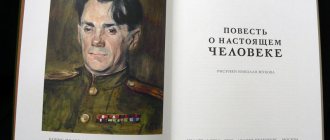Analysis of “The Tale of Peter and Fevronia of Murom”
2.5
(12)
“The Tale of Peter and Fevronia of Murom” National historical basis of the story. The story of Peter and Fevronia is a classic example of a historical and biographical ancient Russian story of the 16th century. The place where the heroes of the story lived and where the events took place was the ancient Russian city of Murom and the Ryazan lands. The events that served as the basis for the story took place in the first half of the 12th century, and the story was written in the late 40s of the 16th century by the eminent clergyman and writer Ermolai Erasmus. He created this great work for the canonization of the new Wonderworkers of Murom - Prince Peter (named David in monasticism) and Princess Fevronia (named Euphrosyne in monasticism).
Since then, the day of these saints has been celebrated on June 25. Connection of the story with folklore. The plot of “The Tale” combines two main fairy-tale plots - a magical tale about fighting a snake and a novelistic tale about a wise peasant girl who marries a noble man and undergoes difficult trials. The story describes the honest, righteous life of the Murom prince Peter and his wife Fevronia, a commoner by birth. Their life and, at the end of it, monastic tonsure bring the story closer to the genre of the lives of saints and give it a moralizing character.
The story seems to grow out of folklore: fairy tales, epics, riddles, proverbs. The story embodies a deep thought, coming from the very beginning of the people's understanding of the equality of people before the truth. So, in the fairy tale, the peasant son Ivan marries the princess, and a simple girl marries the prince. Therefore, the marriage of Prince Peter to Fevronia has roots in Russian folklore and at the same time speaks of incipient changes in Russian society. Peter's feat expresses the ancient mythological, fairy-tale and later epic motif of snake fighting.
By killing the snake, the hero defeats evil and darkness. The snake is depicted in the story as a werewolf; its ability to transform into a human emphasizes the primordial cunning of the devil. It is significant that Peter kills the snake, like a hero, with a treasure sword. Fevronia embodies the fairy-tale image of a wise maiden in the story. Composition of the story. In its structure and composition, “The Tale of Peter and Fevronia of Murom” is exemplary for its genre: at the beginning it tells about the exploits of the heroes, then follows a story about their life, including a story about the triumph of their virtue over life’s trials, then their death is described and, finally , a miracle that occurs after death. The plot of the story. The plot of the story about Peter and Fevronia differs from the traditional hagiographic plot in the following ways: There is no suffering for the faith, no martyrdom of the heroes; No connection to history.
In the center of the story is the peasant girl Fevronia, who agreed to heal Prince Peter, who fell ill from the snake blood that spilled on him. As a reward for this, Fevronia demands that the prince marry her: “I want to cure him, but I don’t demand any reward from him. Here is my word to him: if I do not become his wife, then it is not right for me to treat him.” The cured prince’s attempt to break his promise ends unsuccessfully: Fevronia prudently ordered to smear all his ulcers (received from snake blood), except one, and for the final cure Peter has to fulfill his promise: “Prince Peter went to his patrimony, the city of Murom, recovered. Only one scab remained on him, which was not anointed at the girl’s command. And from that scab new scabs appeared all over his body from the day he went to his patrimony. And again he was covered all over with scabs and ulcers, just like the first time.
And again the prince returned to the girl for the tried and tested treatment. And when he came to her house, he sent to her with food, asking for healing. She, not at all angry, said: “If he becomes my husband, he will be healed.” He gave her a firm word that he would take her as his wife. And again, as before, she prescribed the same treatment for him, which I already wrote about before. He, having quickly recovered, took her as his wife. This is how Fevronia became a princess.” After the death of his brother, Peter takes the throne of the Murom principality.
When the rebellious boyars decide to expel the peasant princess from Murom, she agrees to leave if she is allowed to take with her what she asks. The boyars agree, and the princess asks “only for my husband, Prince Peter.” Peter follows her: “When evening had come, they landed on the shore and began to settle down for the night. Blessed Prince Peter thought: “What will happen now, since I voluntarily renounced the princedom?”
Precious Fevronia tells him: “Do not grieve, prince, the merciful God, the creator and protector of all will not leave us in trouble!” In the end, Peter and Fevronia safely “rule” in Murom; after their “death in the bathtub” (simultaneous death) and separate burial, they nevertheless find themselves reunited “in a single tomb”: “When the time had come for their pious repose, they begged God to die at the same time. And they bequeathed that they should both be placed in one tomb, and they ordered that two coffins be made from one stone, with a thin partition between them. At one time they became monks and donned monastic robes.
And the blessed prince Peter was named David in the monastic rank, and the Venerable Fevronia in the monastic rank was called Euphrosyne.” The ideological content of the story. The images of Peter and Fevronia, who became husband and wife, express the popular ideal of marriage: the righteous and kind strength of the groom is combined with the clarity of the soul, the purity of the bride’s thoughts. The combination of these qualities forms an indissoluble spiritual union of husband and wife, triumphant both in life and in death: “When the time for their pious repose approached, they begged God to die at the same time. And they bequeathed to put both of them in one coffin. And they ordered to make two coffins in one stone, with one partition between them.
They themselves at the same time put on monastic robes. And blessed Prince Peter was called David in monasticism, and the Monk Fevronia was called Euphrosyne in monasticism. In those days, the Venerable and Blessed Fevronia, called Euphrosyne, embroidered with her own hands air for the temple of the Most Pure Cathedral Church, on which the faces of saints were depicted. The venerable and blessed prince Peter, called David, sent to her, saying: “O sister Euphrosyne! My soul already wants to leave my body, but I’m only waiting for you so that I can die together.” She answered: “Wait, sir, until I get air for the holy church.”
He sent to her a second time, saying: “I’ll wait for you a little.” And for the third time he sent, saying: “I want to die and I’m no longer waiting for you.” She embroidered the last air patterns of that saint, but she did not embroider the saint’s robe; Having embroidered the face, she stopped working, stuck her needle in the air and wrapped it in the thread she was sewing with. And she sent to blessed Peter, called David, the news of his simultaneous repose. And, having prayed, they gave up their holy souls into the hands of God on the 25th day of June.” Image of Fevronia. “The heroine of the story is the maiden Fevronia.
She is wise with folk wisdom. She makes wise riddles and knows how to resolve life's difficulties without fuss. She does not object to her enemies and does not insult them with open teaching, but resorts to allegory, the purpose of which is to teach a harmless lesson that her opponents themselves realize their mistakes. She works miracles in passing: she makes the branches stuck for the fire bloom into a large tree overnight. Her life-giving power extends to everything around her. Crumbs of bread in her palm turn into grains of fragrant incense... Fevronia is like Rublev’s quiet angels.
She is the “wise maiden” of fairy tales. External manifestations of her great inner strength are stingy. She is ready for the feat of self-denial, she has conquered her passions. Her love for Prince Peter is invincible externally because she is defeated internally, by herself, subordinated to the mind. At the same time, her wisdom is not only a property of her mind, but to the same extent - her feelings and will.
There is no conflict between her feeling, mind and will: hence the extraordinary “silence” of her image. The first appearance in the story of the girl Fevronia is captured in a visually distinct image. She is found in a simple peasant hut by an envoy of the Murom prince Peter, who fell ill from the poisonous blood of the snake he killed. In a poor peasant dress, Fevronia sat at the loom and was engaged in a “quiet” task - weaving linen, and a hare was jumping in front of her, as if symbolizing her merging with nature. Her questions and answers, her quiet and wise conversation clearly show that “Rublev’s thoughtfulness” is not thoughtless. Fevronia amazes the messenger with her prophetic answers and promises to help the prince... The life-giving power of Fevronia's love is so great that the poles stuck in the ground bloom into trees with her blessing. She is so strong in spirit that she can unravel the thoughts of the people she meets.
In the power of love, in the wisdom suggested to her by this love, Fevronia turns out to be superior even to her ideal husband, Prince Peter” (D. S. Likhachev. Great Heritage). The artistic originality of the story. “The charm of the Tale lies in the simplicity and clarity of the presentation, in the sedate slowness of the story, in the narrator’s ability not to be surprised by the surprising, in the simplicity and good-naturedness of the characters in harmony with the calmness of the narrator... Let us also note the restraint of the narrative, as if echoing the modesty of the manifestation of feelings. The gesture of Fevronia, sticking a needle into the bedspread and wrapping a golden thread around the stuck needle, is as laconic and visually clear as Fevronia’s first appearance in the story, when she was sitting in a hut at a loom, and a hare was jumping in front of her.
To appreciate this gesture of Fevronia wrapping a thread around a needle, we must remember that in ancient Russian literary works there is no everyday life, no detailed descriptions - the action in them takes place as if in cloth. In these conditions, Fevronia’s gesture is precious, like the gold embroidery that she sewed for the “holy” cup” (D. S. Likhachev. Great Heritage). The story in the assessment of literary scholars. “There are disputes about the time of the appearance of “The Tale of Peter and Fevronia of Murom”.
Some researchers attribute it to the 15th century, others to the beginning of the 16th century. Judging by the fact that the church cult of Peter and Fevronia in Murom took shape already in the second half of the 15th century, it is more likely that the “Tale” in some original form unknown to us was compiled already at that time. However, the “Tale” acquired its final form, as R.P. Dmitrieva has now proven, under the pen of Ermolai Erasmus, a writer who worked in the middle of the 16th century. “The Tale of Peter and Fevronia” is a combination of two folklore stories: one about a seducing snake and the other about a wise maiden. These plots in the “Tale” are connected and dedicated to Murom, and the whole story claims to be historically authentic” (D. S. Likhachev. Great Heritage).
2.5 / 5. 12
.
Analysis of “The Tale of Peter and Fevronia of Murom”
“The Tale of Peter and Fevronia” arose in its core no later than the second quarter of the 15th century, but received its final design at the beginning of the 16th century under the pen of Ermolai Erasmus and is closely connected with folklore.
This is a story about the love of Prince Peter and the peasant girl Fevronia - strong and invincible love, “until the grave.”
The first appearance in the story of the girl Fevronia is captured in a visually distinct image. She was found in a simple peasant hut by an envoy of the Murom prince Peter, who fell ill from the poisonous blood of the snake he had killed. In a poor peasant dress, Fevronia sat at the loom and was engaged in a “quiet” task - weaving linen, and a hare was jumping in front of her, as if symbolizing a merger with nature. Her questions and answers, her quiet and wise conversation, clearly show that she is smart. Fevronia amazes the messengers with her prophetic answers and promises to help the prince. Well-versed in healing potions, she heals the prince.
Despite social obstacles, the prince marries the peasant girl Fevronia. Their love does not take into account the opinions of others. The swaggering wives of the boyars disliked Fevronia and demanded her expulsion. Prince Peter renounces the principality and leaves with his wife.
The life-giving power of Fevronia’s love is so great that the poles stuck into the ground, with her blessing, blossom, turning into trees. Crumbs of bread in her palm turn into grains of sacred incense. She is so strong in spirit that she can unravel the thoughts of the people she meets. In the strength of her love, in the wisdom, as if suggested to her by this love, Fevronia turns out to be superior to her ideal husband - Prince Peter.
Death itself cannot separate them. When Peter and Fevronia felt the approach of death, they asked God to let them die at the same time, and prepared a common coffin for themselves. After that they became monks in different monasteries. And so, when Fevronia was embroidering “air” (the cover for the holy cup) for the temple of the Mother of God, Peter sent her to tell her that he was dying, and asked her to die with him. But Fevronia asks to give her time to finish the bedspread. Peter sent to her a second time, ordering her to say: “I won’t wait long enough for you.” Finally, sending her for the third time, Peter tells her: “I already want to die and I’m not waiting for you.” Then Fevronia, who had only one robe left to finish, stuck a needle into the bedspread, wrapped a thread around it and sent it to tell Peter that she was ready to die with him.
After the death of Peter and Fevronia, people placed their bodies in separate coffins, but the next day their bodies ended up in a common, pre-prepared coffin. People tried to separate Peter and Fevronia for the second time, but again their bodies ended up together, and from then on they no longer dared to separate them.
The images of the heroes of this story, whom neither the boyars nor death itself could separate, are surprisingly psychological for their time. Their psychological nature is outwardly manifested with great restraint.
Let us also note the restraint of the narrative, as if echoing the modesty of the manifestation of feelings. The gesture of Fevronia, sticking a needle into the bedspread and wrapping a golden thread around the stuck needle, is as laconic and visually clear as Fevronia’s first appearance in the story.
To appreciate this gesture of the heroine, we must remember that in ancient Russian literary works there is no everyday life, no detailed descriptions. In these conditions, Fevronia’s gesture is precious, like the gold embroidery that she sewed for the holy cup.
Peter and Fevronia. Plot summary
Prince Pavel ruled in the city of Murom. And suddenly the Serpent in the guise of Paul began to fly to his wife for fornication. She immediately told her husband about this. He immediately asked her that at the next meeting with the Serpent, she would flatteringly find out from him what he expects his death from. The humble wife did just that. Seduced by her beauty and gentle speeches, the Serpent told her the secret of his death, which was that Peter would kill him with the help of Agrikov’s sword. Concerned about this news, Pavel calls brother Peter to him and tells him everything. And he was ready to fight the enemy, however, he did not know where he could get Agrikov’s sword.
Analysis of “The Tale of Peter and Fevronia of Murom”
“The Tale of Peter and Fevronia of Murom” is a story about the strong and invincible love of Prince Peter and a simple girl Fevronia, who lived in the 13th century and are canonized. Their marital union is a model of Christian marriage.
Fevronia is found by a messenger from Prince Peter, who fell ill from the poison contained in the blood of the serpent he defeated. The girl appears before the reader in a simple peasant dress, she sits at a loom in a poor peasant hut. However, her quiet and wise speech clearly shows that she is very intelligent. Fevronia amazes the envoys with her answers and agrees to help the prince. She heals Prince Peter with her healing potions.
Despite all social obstacles, the prince marries the peasant girl Fevronia. Their love does not need the approval of others. However, the boyars disliked Fevronia and demanded her expulsion. For the sake of his beloved, Prince Peter renounces the principality.
Even death itself could not separate them. When the couple felt the approach of their death, they began to pray to God for a common death and prepared a common coffin for themselves. Then each of them went to a monastery and became a monk.
After the death, the bodies of Peter and Fevronia, contrary to their will, were placed in separate coffins. However, the next day their bodies miraculously ended up in a common coffin, which they had prepared in advance. People once again tried to separate the couple, but their bodies inexplicably ended up back together. From then on, they no longer dared to separate Peter and Fevronia.
The images of the heroes of this story, whom neither society nor death itself could separate, are surprisingly psychological for their time. “The Tale of Peter and Fevronia of Murom” amazingly combines characteristic elements of fairy tales and everyday life, demonstrates integral images of its heroes and is an example of the pious lives of saints, which reflects folk wisdom, as well as the ideal idea of the Russian people about good family relationships.
Read further:
Essay on the work “The Tale of Peter and Fevronia of Murom”
Essay about Fevronia of Murom
Analysis of “The Tale of Bygone Years”: Essays, Unified State Examination in Literature 2014
The story “Blizzard” by A.S. Pushkin reveals the theme of chance in the fate of a person
Essay on the topic “Fevronia of Murom”
“The Tale of a Real Man” summary
The story “Heart of a Dog” by M. Bulgakov: fantastic and real
The story of V. Rasputin “Farewell to Matera”
The story of V. Rasputin “Farewell to Matera”
What did the story by V.G. make me think about? Korolenko "In Bad Society"
Dystopian story by A. P. Platonov “The Pit”
Dystopian story by A. P. Platonov “The Pit”









